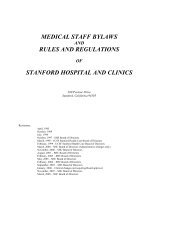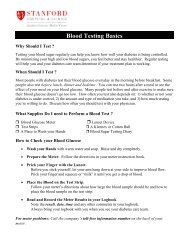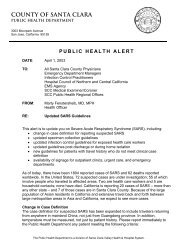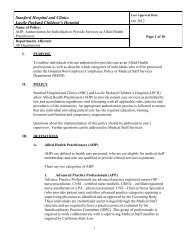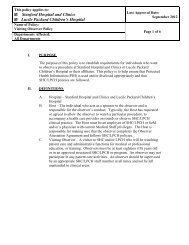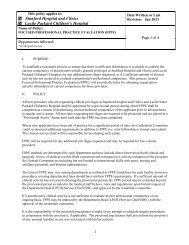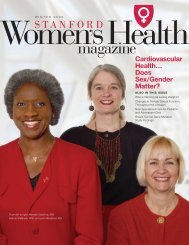Fall/Winter 2007 - Stanford Hospital & Clinics
Fall/Winter 2007 - Stanford Hospital & Clinics
Fall/Winter 2007 - Stanford Hospital & Clinics
You also want an ePaper? Increase the reach of your titles
YUMPU automatically turns print PDFs into web optimized ePapers that Google loves.
S tanford ACCESS <strong>Fall</strong>/<strong>Winter</strong> <strong>2007</strong><br />
<strong>Stanford</strong>’s Program for<br />
Pediatric and Adolescent<br />
Gynecology currently offers a<br />
comprehensive range of<br />
services, and works closely<br />
with <strong>Stanford</strong> <strong>Hospital</strong> &<br />
<strong>Clinics</strong> and Lucile Packard<br />
Children’s <strong>Hospital</strong> at<br />
<strong>Stanford</strong> to offer a full range<br />
of clinical specialists,<br />
subspecialties,<br />
and research protocols.<br />
sexual matters as the parent thinks<br />
she is. “When you talk to the daughter<br />
alone you find she already needs<br />
contraception and she’s at risk for<br />
STDs. She hasn’t told mom this, even<br />
though mom says, ‘My daughter tells<br />
me everything.’ This happens over<br />
and over again.”<br />
“At the first visit, we encourage the<br />
daughter to discuss her contraceptive<br />
needs with her mother. We need to<br />
help draw that mom into the care,<br />
set the stage for daughter to talk to<br />
mom, but meanwhile you don’t want<br />
the daughter to get pregnant. At that<br />
visit we may recommend birth control<br />
pills for menstrual cramps and<br />
irregular periods. We never leave out<br />
the family context, whether the family<br />
is a traditional mom or a statesponsored<br />
guardian,” Hillard says.<br />
Mothers also need to understand<br />
that their own experiences are not<br />
necessarily parallel to what their<br />
daughters are going through. Hillard<br />
said a study she and her colleagues<br />
did while she was at the University of<br />
Cincinnati revealed that mothers suffering<br />
from PMS would assume –<br />
consistently incorrectly – that their<br />
daughters were experiencing the<br />
same thing.<br />
Frequently the parent worries even<br />
before the daughter can possibly<br />
know what’s wrong. Lacy points to a<br />
6-month-old infant’s mother who<br />
understandably was upset after an<br />
ultrasound revealed an incidental<br />
PAULA J. ADAMS HILLARD, MD<br />
Professor of Obstetrics and Gyencology<br />
Chief of the Division of Gynecologic Specialties<br />
finding that her daughter appeared to<br />
have a uterine anomaly. “In this case<br />
the finding transcended the limits of<br />
ultrasound technology and was not<br />
Paula Hillard obtained her medical degree from <strong>Stanford</strong> University School of<br />
Medicine and completed a residency in obstetrics and gynecology at the University<br />
of North Carolina, Chapel Hill. She then joined the faculty of the University<br />
of Virginia as Director of Ambulatory OB/GYN. Dr. Hillard was a member of the<br />
Department of OB/GYN at the University of Cincinnati from 1984-<strong>2007</strong>, and<br />
was the Director of Women’s Health for the University of Cincinnati College of<br />
Medicine. She has also served as Chief of Gynecology and Obstetrics at Cincinnati<br />
Children’s <strong>Hospital</strong> Medical Center, where she founded and directed the fellowship<br />
program in Pediatric and Adolescent Gynecology.<br />
She has been active on a number of national medical committees, including<br />
chair of the American College of Obstetricians and Gynecologists’ (ACOG)<br />
Committees on Patient Education, Adolescent Health, and Guidelines for<br />
Women’s Health. She is a past president of the North American Society for Pediatric<br />
and Adolescent Gynecology. She is an active contributor to the literature in<br />
adolescent gynecology and contraception with over 100 journal articles and<br />
abstracts published. She speaks frequently at national and international meetings<br />
and postgraduate courses on topics in ambulatory obstetrics and gynecology,<br />
pediatric and adolescent gynecology, cervical cancer screening, interpersonal violence,<br />
and primary care. Her clinical work has earned the designation as one of<br />
the “Best Doctors for Women” from Good Housekeeping Magazine.<br />
For consultation, Dr. Hillard can be reached at Paula.hillard@stanford.edu or<br />
(650) 725-5986.<br />
JUDITH A. LACY, MD<br />
Clinical Instructor<br />
Pediatric and Adolescent Gynecology<br />
Division of Gynecologic Specialties<br />
Department of Obstetrics and Gynecology<br />
After attending medical school at Oregon Health and Science University, Judith<br />
Lacy completed her OB/GYN residency at Duke University Medical Center. She<br />
then went on to complete a fellowship in pediatric and adolescent gynecology at<br />
the <strong>Hospital</strong> for Sick Children, affiliated with the University of Toronto.<br />
Dr. Lacy’s current interests include congenital anomalies of the female reproductive<br />
tract, ovarian preservation in adolescents and women undergoing<br />
chemotherapy, human papilloma virus and the HPV vaccine, polycystic ovarian<br />
syndrome, endometriosis in adolescents and adult women, management of menorrhagia<br />
in adolescents and adult women, and diagnosis and management of vulvovaginitis<br />
and vulvar dermatoses in the pediatric population.<br />
Judy can be reached at (650) 725-0601 or jalacy@stanford.edu for consultations<br />
with colleagues.<br />
3





